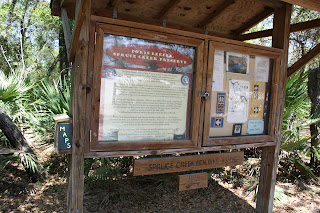As FAM 2011 neared its end, I anticipated our visit to Spruce Creek Preserve in New Smyrna Beach. Besides being gorgeous, the Preserve offers an excellent place to bike, walk, and photograph, while also harboring two of our favorite things: native plants and archaeology!
 |
| A kiosk describing the Preserve-- and its archaeological significance-- greets visitors. |
As a resident of New Smyrna, a nature enthusiast, and a lover of archaeology, my anticipation for exploring Spruce Creek Preserve through an archaeological lens was high. Embarking down the path with the many hikers and bikers, I was eager as them to know more about the land and the people who used it. Mark Wheeler, a native plants specialist, led the group to the mound. Along the path, Wheeler spotted wild blueberry, saw palmetto, cabbage palm, beautyberry, live oak, red bay, spanish moss, muscadine grape, and coontie.
 |
| Wheeler describes Florida's native plants and how native peoples used them. |
Native Americans used beautyberry as a treatment for skin and stomach disorders as well as colic. Red bay could be utilized as to relieve pain and, occasionally, as a "love potion." Native peoples understood how to harvest beneficial qualities of plants. Learning which plants could be used for what purpose, however, was not an easy process. Coontie, for example, provides a flour-like food AFTER boiling the roots to remove the toxin cycasin. While learning about how native plants can be used for food, shelter, clothing, and other purposes, it is best not to make the experience a hands on one! Tasting and experimenting plants can be dangerous. Native peoples learned how to use plants as sources of food, clothing, and shelter over time with experimentation that surely ended in unexpected health conditions, sickness, or death.
|
| Amber and the group pause to enjoy the scenery. |
 |
| Hikers approach the heavily vegetated mound. |
The mounds, closed to the public for preservation purposes, sit just off the path overlooking Spruce Creek. Although the area's history spotted with archaeological investigation, the mound remains shrouded in mystery.
 |
| Sarah talks about the mound's history. |
A.M. Harrison's 1874 investigation led him to believe natives constructed a 40 foot high, irregularly shaped mound from "borrow pits" that are 8 to 12 feet deep. Natives removed sand in trench-like pits to build up the mound. Surprisingly, only half the dirt needed to build the mound came from these pits. Since 1874, at least three archaeological excavations were conducted at the mound with the most recent done during 2005. Unfortunately, the site has been repeatedly damaged in past years. Locals, for example, would bring visitors to dig at the mound for entertainment in the late 1900s and, in more recent years, the larger mound served as a dirt bike ramp. While archaeologists can continue to investigate the mounds, the information lost in previous, non-archaeological excavations damages interpretations.
 |
2005 map shows the mound with a smaller mound to the
west and a canoe ramp from the creek. |
 |
The bikers learn that the mound dates to St. Johns IIc period,
characterized by the appearance of European artifacts in mounds. |
 |
| Two bikers hike the trail at the end of an amazing tour. |
If you are interested in learning more about the Preserve, plants, or mounds in Volusia County, visit these online resources:
Website for Spruce Creek Preserve:
http://www.volusia.com/sprucecreek/







